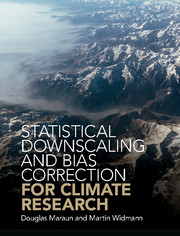Book contents
- Frontmatter
- Dedication
- Contents
- Preface
- Acknowledgements
- 1 Introduction
- Part I Background and Fundamentals
- Part II Statistical Downscaling Concepts and Methods
- 10 Structure of Statistical Downscaling Methods
- 11 Perfect Prognosis
- 12 Model Output Statistics
- 13 Weather Generators
- 14 Other Approaches
- Part III Downscaling in Practice and Outlook
- Appendix A Methods Used in This Book
- Appendix B Useful Resources
- References
- Index
14 - Other Approaches
from Part II - Statistical Downscaling Concepts and Methods
Published online by Cambridge University Press: 27 December 2017
- Frontmatter
- Dedication
- Contents
- Preface
- Acknowledgements
- 1 Introduction
- Part I Background and Fundamentals
- Part II Statistical Downscaling Concepts and Methods
- 10 Structure of Statistical Downscaling Methods
- 11 Perfect Prognosis
- 12 Model Output Statistics
- 13 Weather Generators
- 14 Other Approaches
- Part III Downscaling in Practice and Outlook
- Appendix A Methods Used in This Book
- Appendix B Useful Resources
- References
- Index
Summary
In addition to dynamical downscaling, and the PP and MOS statistical approaches presented in Chapters 11 and 12 there are a number of alternative downscaling methods that combine different approaches. These will now be outlined, and some examples will be given.
Statistical-Dynamical Downscaling and Emulators
There are combinations of dynamical and statistical downscaling that are different from the MOS post-processing. They aim at using the physically based small-scale information from RCMs but without performing computationally expensive RCM runs for every timestep and ensemble member of the GCM simulations to be downscaled. In contrast to standard PP downscaling, which is also an alternative to dynamical downscaling, these approaches are not restricted by the availability of observations for model fitting and provide values for the same region and grid as the RCM. The output is thus spatially complete and can be produced for regions without any observations.
Statistical-Dynamical Downscaling
The first type of this approach is known as statistical-dynamical downscaling. It exploits the fact that many of the large-scale atmospheric states that usually would be used to drive an RCM are similar. The idea is that running the RCM for each situation in a set of similar states creates redundant information and can thus be avoided. Instead, the RCM is only run for typical weather situations, and then the final output is generated by a weighted average of the RCM outputs for the typical situations, with weights determined by the frequency of these weather types in the target period. The approach goes back to wind field studies by Wippermann and Gross (1981) and Heimann (1986) and has been introduced for downscaling of climate models by Frey-Buness et al. (1995). Fuentes and Heimann (2000) have improved the definition of the weather types and demonstrated skill comparable to full RCM simulations for winter precipitation in the Alps for the period 1981–1992. The approach has been used for instance for downscaling windstorm impacts over Germany from climate change simulations (Pinto et al. 2010) and near-surface wind fields from decadal hindcasts and climate change simulations, which in turn were used for wind energy estimates (Reyers et al. 2015).
- Type
- Chapter
- Information
- Statistical Downscaling and Bias Correction for Climate Research , pp. 220 - 224Publisher: Cambridge University PressPrint publication year: 2018

